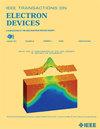用CSS法制备CdZnTe光子计数探测器:Te2气氛退火调控
IF 3.2
2区 工程技术
Q2 ENGINEERING, ELECTRICAL & ELECTRONIC
引用次数: 0
摘要
具有能量分辨能力的CdZnTe (CZT)光子计数探测器是未来医用x射线成像的主要发展方向之一。在过去的几十年里,熔体生长法被广泛用于制备CZT光子计数探测器。然而,由于难以制造无缺陷大面积晶圆,这种方法的生长周期长,成本高。封闭间隙升华(CSS)气相生长法生长的CZT单晶有望有效降低成本。在本研究中,通过CSS方法生长的外延CZT晶体在Te2气氛中退火,导致探测器的光子计数性能显著增强。研究了退火温度与载流子输运特性的关系,以及CZT晶体中深能级缺陷的调控及其对光子计数特性的影响。目的是确定最佳退火温度,作为提高CZT外延晶体探测器性能的有效策略。我们系统地分析了探测器的电学特性,如电阻率、漏电流、能量分辨率和载流子迁移寿命乘积,并开发了计数率高达2.87M CPS/mm2的CZT光子计数探测器。研究结果为提高CZT外延晶体探测器的性能提供了有价值的理论和实验基础指导。本文章由计算机程序翻译,如有差异,请以英文原文为准。
Preparation of CdZnTe Photon-Counting Detectors by CSS Method: Annealing Regulation in Te2 Atmosphere
The CdZnTe (CZT) photon-counting detector with energy discrimination capabilities is one of the primary development directions for future medical X-ray imaging. Over the past few decades, the melt growth method has been commonly used for preparing CZT photon-counting detectors. However, this method has a long growth cycle and high cost due to the difficulty in manufacturing defect-free large-area wafers. CZT single crystals grown by closed-spaced sublimation (CSS) vapor phase growth method are expected to enable effective cost reduction. In this study, epitaxial CZT crystals grown by the CSS method were annealed in a Te2 atmosphere, resulting in a significant enhancement of the detectors’ photon-counting performance. The research investigates the relationship between annealing temperature and carrier transport properties, as well as the regulation of deep-level defects in CZT crystals and their impact on photon-counting characteristics. The goal is to determine the optimal annealing temperature as an effective strategy for improving the performance of CZT epitaxial crystal detectors. We systematically analyzed the electrical properties of detectors, such as resistivity, leakage current, energy resolution, and carrier mobility-lifetime product, and developed a CZT photon-counting detector with a high counting rate of 2.87M CPS/mm2. The results offer valuable theoretical and experimental foundations guidance for enhancing the performance of CZT epitaxial crystal detectors.
求助全文
通过发布文献求助,成功后即可免费获取论文全文。
去求助
来源期刊

IEEE Transactions on Electron Devices
工程技术-工程:电子与电气
CiteScore
5.80
自引率
16.10%
发文量
937
审稿时长
3.8 months
期刊介绍:
IEEE Transactions on Electron Devices publishes original and significant contributions relating to the theory, modeling, design, performance and reliability of electron and ion integrated circuit devices and interconnects, involving insulators, metals, organic materials, micro-plasmas, semiconductors, quantum-effect structures, vacuum devices, and emerging materials with applications in bioelectronics, biomedical electronics, computation, communications, displays, microelectromechanics, imaging, micro-actuators, nanoelectronics, optoelectronics, photovoltaics, power ICs and micro-sensors. Tutorial and review papers on these subjects are also published and occasional special issues appear to present a collection of papers which treat particular areas in more depth and breadth.
 求助内容:
求助内容: 应助结果提醒方式:
应助结果提醒方式:


